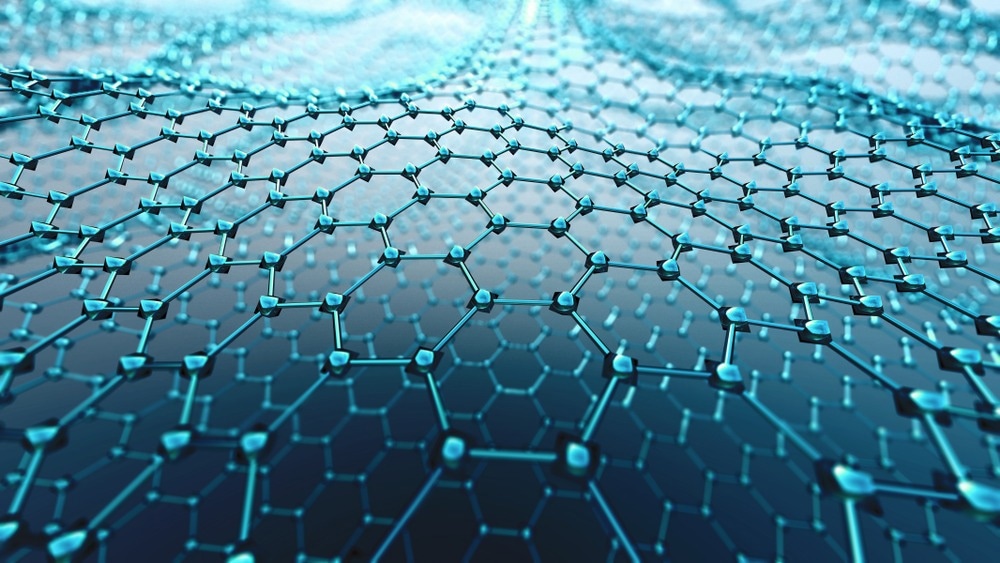Graphene is a suitable active substance for electric double-layer supercapacitors (EDLCs) because of its high electric conductance and lightweight composition. However, a porous configuration is needed to maximize the specific energy density of graphene for many novel energy storage applications.

Study: Soft Template-Assisted Fabrication of Mesoporous Graphenes for High-Performance Energy Storage Systems. Image Credit: Neon_dust/Shutterstock.com
A recent study published in the journal ACS Applied Materials & Interfaces proposes a simple strategy for the fabrication of mesoporous graphene with applications in high-performance energy storage systems such as electric double-layer supercapacitors (EDLCs).
Electric Double Layer Capacitors (EDLCs): Overview and Challenges
Energy storage systems have recently received significant attention due to the urgent need to replace fossil fuels in many industrial sectors, such as transportation. In this context, electric double-layer capacitors (EDLCs) are important energy storage systems because of their high energy density and exceptional cyclic stability.
However, conventional energy storage systems made of activated carbons (ACs) have a poor power density due to the insufficient specific contact area, leading to the inadequate creation of an electric double layer between electrode material and electrolyte.
As a result, an active substance with a high specific contact area must be developed to obtain high energy densities and meet the needs of novel energy storage systems.
Previous studies have attempted to create high surface area carbon-based compounds, such as highly porous structured carbons, for energy storage purposes. However, conventional carbon-based materials have low conductance, resulting in low power density and poor cyclic stability.
Mesoporous Graphene for Energy Storage Applications
Graphene is regarded as a potential carbonaceous material because of its remarkable electrical conductance. However, the high van der Waals contact between the graphene sheets makes stacking unavoidable, producing a limited available surface area.
This inherent graphene disadvantage can be overcome by adding a three-dimensional (3D) porous microstructure, which increases the available surface area while retaining beneficial electrical properties.
The resultant material, known as mesoporous graphene, combines the benefits of graphene, ultrathin 2D morphology, and mesoporous structures, significantly improving the power and energy densities of energy storage devices such as electric double-layer capacitors (EDLCs).
Several research groups have attempted synthesizing 3D mesoporous graphene using a catalytic template-assisted technique. However, due to a volatile catalytic template, the pore diameter and contact area were rather high. Therefore, developing an efficient technique for synthesizing 3D mesoporous graphene with a high contact area for high-energy-density EDLCs remains a major challenge.
What Did the Researchers Do in This Study?
In this study, the researchers created 3D mesoporous graphene by employing block copolymers (BCPs) to construct the mesostructured active template and the carbon resource. An amphiphilic poly(styrene)-block-poly (2-vinyl pyridine) copolymer (PS-b-P2VP) was swelled in heated ethanol and then dehydrated to create a mesostructured template.
Electroless plating produced the reactive template by selectively depositing a nickel precursor as a graphene catalyst on the P2VP layer.
Interestingly, the highly porous architecture of mesoporous graphene was successfully preserved during catalytic decomposition even at high temperatures since the mechanical resilience of the PS-b-P2VP composite is adequate to act as rigid reinforcement and inhibit nickel catalyst aggregation.
The surface of as-prepared mesoporous graphene was studied using cutting-edge techniques such as transmission electron microscopy (TEM), X-ray diffraction (XRD), and scanning electron microscopy (SEM). The Barrett-Joyner-Halenda (BJH) technique was used to compute the pore size distribution in mesoporous graphene particles from the adsorption and desorption branches.
Important Highlights of the Research
The mesostructured templates properly sustained their architectures without structural failure in high-temperature catalytic decomposition, allowing the synthesis of mesoporous graphene with a pore diameter of 3.5 nanometers. The as-prepared mesoporous graphene had a bi-continuous shape, with graphene assembling into 3D mesopores with a large contact area.
The large specific contact area and small pore diameter allowed a considerable number of electrolytes to enter mesoporous graphene. Moreover, the electrically conducting pathways in the mesoporous graphene sheets resulted in highly efficient interfacial electron transfer.
When mesoporous graphene and ionic fluids were utilized as electrode material and electrolytes, the resultant EDLC demonstrated high-voltage performance and remarkable energy storage efficiency, including high specific capacitance, high power density, and good cyclic stability.
These findings suggest that mesoporous graphene might be a promising carbon material for fabricating high-performance electrolytic energy storage systems.
Reference
Kim, K.-W. et al. (2022). Soft Template-Assisted Fabrication of Mesoporous Graphenes for High-Performance Energy Storage Systems. ACS Applied Materials & Interfaces. Available at: https://pubs.acs.org/doi/10.1021/acsami.2c12948
Disclaimer: The views expressed here are those of the author expressed in their private capacity and do not necessarily represent the views of AZoM.com Limited T/A AZoNetwork the owner and operator of this website. This disclaimer forms part of the Terms and conditions of use of this website.